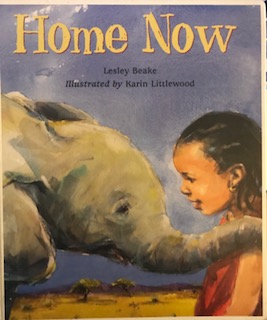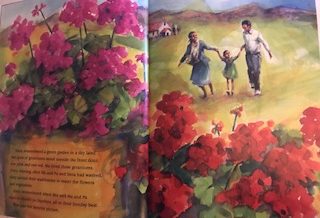
Title: Home Now
Author: Lesley Beake
Illustrator: Karin Littlewood
Publisher: Charlesbridge
Year: 2006
Number of Pages: 28
Tags: Animals, Culture, Emotion, Family, Fiction, Friendship, Picture Book, K-5, Taylor Krueger
Genre: Fiction Children’s Book
Analysis: This book shares the story of a girl, Sieta, who lost her mother at a very young age. She moved in with Aunty after the death of her mother, but her new home does not feel comfortable. Sieta went to the Kruger National Park with her class and fell in love with the smallest elephant, Satara. Their friendship continued to grow and led to a special bond. Sieta learned to appreciate her new life and saw the strength and care of the people of her town. She was sad she couldn’t experience this with her mother, but she knows her mother is watching with happiness.
The illustrations of this book encompass a variety of borders, colors, and depth. The images are mostly bordered by the edges of the pages. The framed illustrations allow the reader to experience the life of Sieta. The depth of the images invite the reader to look more into the emotions of the characters, and an experience into the culture of her new life. The reader see ms to always be watching from afar rather than being present in the scenes. The illustrations create a window into the world of this town and the ways the people live. There are smaller illustrations that are scattered on the pages. These show a
ms to always be watching from afar rather than being present in the scenes. The illustrations create a window into the world of this town and the ways the people live. There are smaller illustrations that are scattered on the pages. These show a
time lapse of certain experiences of the main character, Sieta. For example, when she searches for the baby elephant, Satara, in the zoo there are multiple images showing her journey to find him. These illustrations are light-hearted and have a soft whimsical type of border.
The colors used throughout the book are very bright and vibrant. The use of the colors connect to the story and emotions of the characters. There are many bright blues, purples, and pinks seen in the illustrations of Sieta and Satara, which shows the joy of their newfound friendship. The illustrator uses thick brushstrokes throughout the book that allow soft lines that are blurred. This shows the softness of the characters and are very welcoming to the reader. The images are very unique and relate to the interesting town that Sieta moves to.
The illustrations of the characters and settings have the perceptual view of a young girl adjusting to a new home. There are depictions of Sieta playing with her parents in the past, meeting Satara the baby elephant, and finding a new love for her home. The structural view of the characters shows a representation of strength as Sieta is adjusting to her new home. The facial expressions of the characters further elaborate the feelings of the characters. Sieta is shown to be sad and unhappy when she first arrived at her new home, but once she meets Satara she is smiling depicting her newfound happiness.
This book shows the ideological issue of children who has a parent that passes away from AIDS and/or other illnesses. Sieta watched her mother get weaker and more sick as her family slowly crumbled. She had to adjust to this new home without her main support system, her mother. This gives information on a topic that might have been unknown to the reader. This book allows the reader to experience the emotions and sadness Sieta had to go through. It shows young children the story of a character and the struggles she faces on her journey to happiness.
This book is a representation of a multimodal text. There is an interaction between the text and the illustrations that help the reader fill in the gaps. The illustrations further enhance the meaning of the text and gives the reader a visual representation of the words. The text and illustrations elaborate the message of the story.
At the end of the book there is a note that further elaborates the message of the story. It gives insight on the relations of the story to children who have parents with AIDS. The note sends information to the reader that may not have been known. It spreads awareness to the readers of how the infection of AIDS impacts the lives of people and their families.
